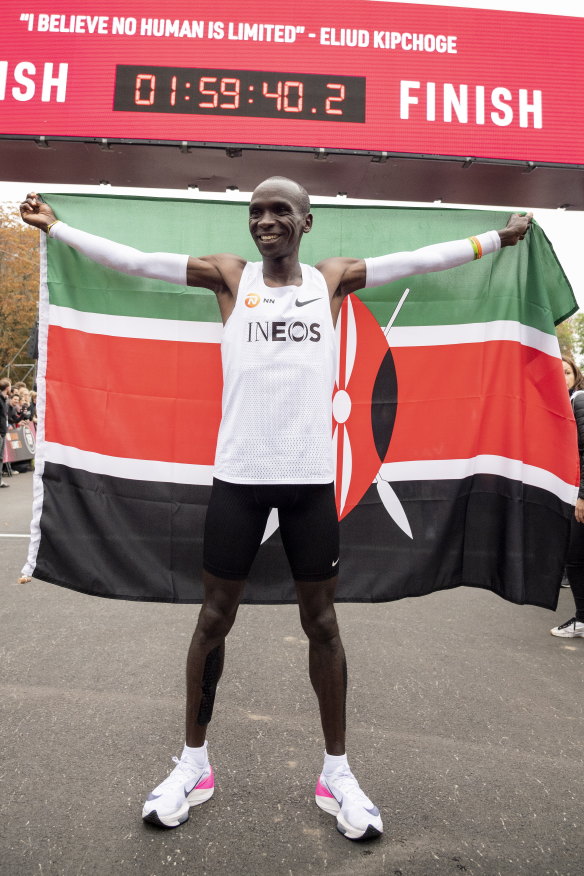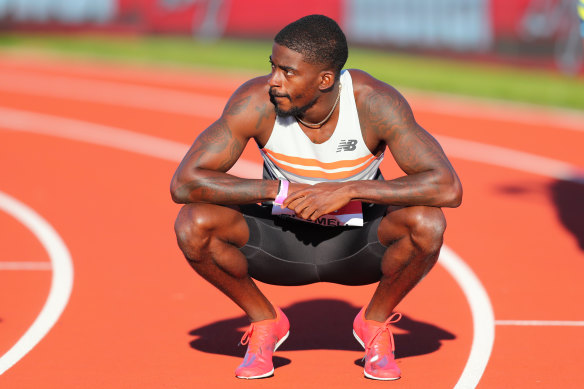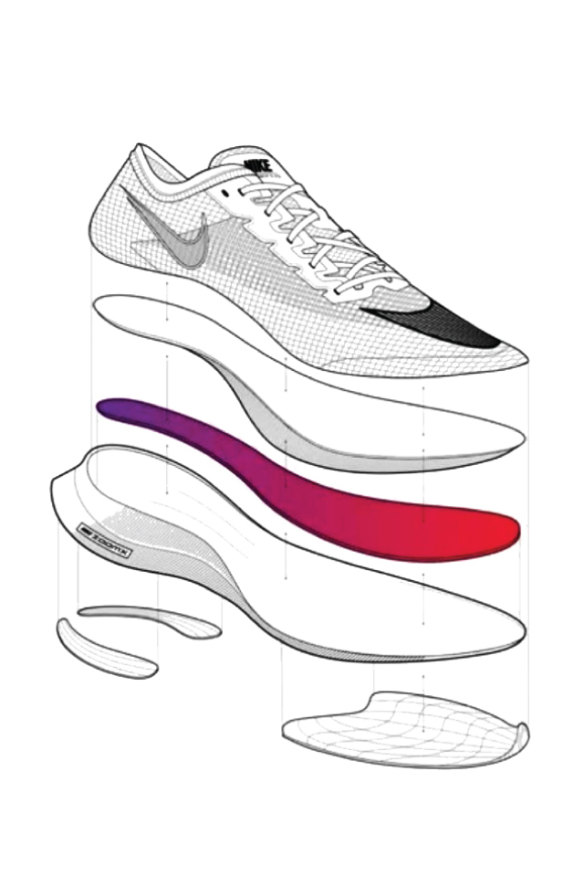Explainer
- Explainer
- Tokyo Olympics
A spring in your step: What’s inside the new running ‘super’ shoes?
Nearly every road runner and some big track stars at these Olympics are wearing a new type of shoe – that have ignited debate. Why?
With little sign of strain on his face and fists beating his chest, Eliud Kipchoge redefined what many considered possible for a human to achieve when he became the first person to run a marathon in less than two hours on a chilly morning in Vienna in 2019.
Kipchoge’s time of one hour, 59 minutes and 40 seconds for the 42.195-kilometre race was stunning. As he ran the last few hundred metres, commentators compared his achievement to Neil Armstrong walking on the moon, Edmund Hillary climbing Mount Everest and Roger Bannister running the first four-minute mile.
Kipchoge’s record run was an exhibition event so he was allowed certain aids, such as people running beside him to keep up the pace. He ran on a mostly straight and flat course and the track was tree-lined to stop wind hitting him. All of this meant his run time was not considered an official world record, although he holds that anyway with 2:01:39. And those special conditions no doubt helped Kipchoge achieve his time, along with his intense training. But none of those factors was as controversial as what he wore on his feet.
His shoes were judged by fellow athletes, fans and media alike as integral to his time. And his feat, in those shoes, reignited questions about natural achievement versus technology, and what human ingenuity can help our species do. The conversation is only set to intensify with the same shoes allowed in competition at this year’s Olympics. So what are the issues?

Eliud Kipchoge celebrates his “record” marathon time in Vienna in 2019.Credit: EPA
What was he wearing?
Kipchoge wore a “super shoe”, first developed by Nike in 2016 and now mimicked by other brands. What makes them “super” is a thin carbon fibre plate wedged inside a midsole made of a tremendously squishy, bouncy and pliant plastic.
The version Kipchoge wore in Vienna, the Vaporfly, was a prototype unavailable to the public or any other athletes at the time, and some dubbed it similar to “platform shoes” given the size of the heel.
While technological developments have revolutionised recovery, nutrition, aerodynamic form, race track materials and training methods in athletics over the years, there had been little in those advancements that made runners and fans question, so profoundly, the purity of the sport.
“We live in the 21st century and we need to accept change,” Kipchoge told reporters of his shoes. “Development goes hand in hand with technology. The shoe is good. We are doing a press conference virtually, is that not technology? We should accept technology and marry technology.”
Once the first versions of these shoes slipped onto the feet of elite athletes, records fell at unprecedented rates. Nike has now also developed a couple of “super shoe” models for track racing, which are also helping break records.
In a staggering period between 2016 and 2020, every male and female world record from the five-kilometre run to the marathon – of which there are 17 – was broken. Fourteen were broken in super shoes. It’s expected more will tumble in Tokyo.
“Recent improvements in long-distance running world records are unlikely physiological but rather technological,” a study on the super shoes and their record-breaking pedigree in the journal Sports Medicine concluded.
“Current shoe designs for road running, and more recently for track running, that include a CFP [carbon-fibre plate] seem to greatly reduce the energy cost of running.”
This run of records reminded sports fans of swimming’s “super suit” era, where a more buoyant swimsuit helped athletes break time after time. They were eventually banned.
The “super shoes” have not been banned but World Athletics has introduced rules to ensure midsoles do not become thicker than 40 millimetres for road races (see rules below) and that they do not have more than one carbon-fibre plate inside them.

Trayvon Bromell in ‘super’ shoes after winning the men’s 100 metres during the Muller British Grand Prix in July. Credit: Getty Images
What’s so special about ‘super shoes’?
Wearing super shoes is a bit like wearing springs, says Australian marathon record holder Robert de Castella.
The theory goes that the squishy foam midsole, made out of lightweight, pliant plastics known as EVA, TPU and Pebax, acts like a spring that bounces back from underneath athletes when they run.
Depending on how it is manufactured, Pebax can come in squishy form (as in super shoes) or can be more rigid, as in helmets, ski boots and even catheters used by heart surgeons. EVA and TPU had been used before in runners but Pebax had not, until Nike developed it in 2016 to create a midsole material that was lightweight, very soft and springy (it bounced back).
Geoff Burns is a running, biomechanics and physiology expert from the University of Michigan who has written extensively about super shoes and is one of the world’s leading experts on the topic. He calls Pebax foam “incredible”.
“Just because you have a thick-sole shoe does not mean it’s going to be a performance benefit,” he says.
The carbon-fibre plate acts to stabilise the pliancy of the midsole but also, according to research from the University of Colorado, “enhances how the human foot acts like a lever” at the point where the forefoot leaves the ground when running.

A cross-section of a Vaporfly shoe showing the carbon fibre plate (in pink) sandwiched between squishy foam midsoles.Credit: Nike
A Sports Medicine study from 2021 agrees with that lever theory, and goes on to speculate that this also reduces the energy required to keep moving forward, working alongside the squishy foam base.
Researchers in the University of Colorado’s “locomotion lab” compared a prototype of Nike’s super shoe with two regular types of runners. Eighteen “high-calibre” athletes ran in each shoe and the researchers found that they used 4 per cent less energy on average when running in the Nike super shoes.
“Compared with the established racing shoes, the new shoes reduced the energetic cost of running in all 18 subjects tested … the energetic cost for running in the [prototype] was 4.16 per cent and 4.01 per cent lower than in the [normal marathon] shoes,” the study reads.
This study was funded by Nike, although the team that carried it out is considered to have a “sterling reputation”, according to Burns.
Two other studies have backed up the original Nike study to find that wearing the super shoes reduces the energy used to run, one from Brigham Young University in Utah and another from Grand Valley State University in Michigan.
None of these studies seeks to definitively determine why or how the super shoes make running easier, and there have been no definitive studies since that have made such a conclusion.
The original University of Colorado study speculates it is because the soft foam midsole makes an athlete’s knee bend less when their foot strikes the ground. This, the researchers say, means people remain more balanced when running, which also means your leg stays stiff.
“When running on compliant surfaces, people maintain their centre of mass mechanics by reducing knee flexion during the stance period, which increases leg stiffness,” the study reads. “This improves the mechanical advantage of the muscles acting around the joints, which reduces the energetic cost of body weight support.”
Track athletes have long worn shoes with spikes, for grip. Burns says the benefits of the technology in track spikes such as the Nike Dragonfly are less well known, with not enough research on them available. He is still unequivocal in his opinion that they help, as are most athletes, media and fans.
“I can see an argument for the spikes being in the order of, you know, 2 to 2½ per cent more efficient than a traditional track spike. And I think we’re kind of starting to see that with the way that these races and comparative athlete performances are playing out,” Burns says.
Nike’s track versions – the Air Zoom MaxFly (100 metres to 400 metres), the Air Zoom Victory (for 800-metre to five-kilometre races) and the ZoomX Dragonfly (1500 metres to 10,000 metres) – all have a relatively thick squishy foam midsole for a track shoe, which are usually very thin. The Victory and MaxFly have a carbon-fibre plate inside the midsole, and soft plastic air cushions on the forefoot, while the Dragonfly has a hard plastic plate within the foam midsole.
In February, Nike shelved plans to release a 100-metre super sprint spike called the Viperfly for the Olympics. According to The Times, the shoe generated lightning-fast times in testing. Experts did not think it would pass World Athletics shoe regulations, The Times reported, “amid concerns that its spike plate was acting as a secondary spring”. World Athletics rules state runners cannot provide “unfair assistance or advantage”.
Eight-time Olympic gold medallist Usain Bolt is not a fan of super spikes on the track. The sprinter wore Puma spikes through his 2008 to 2016 Olympic career, well before the technology was available in track shoes. “When I was told about it, I couldn’t believe that this is what we have gone to,” Bolt told Reuters. “You know what I mean? That we are really adjusting the spikes to a level where it’s now giving athletes an advantage to run even faster.
“It’s weird and unfair for a lot of athletes because I know that in the past [shoe companies] actually tried and the governing body said, ‘No, you can’t change the spikes’. So to know that now they are actually doing it, it’s laughable.”
What are the World Athletics rules for running shoes?
- Shoe must be on World Athletics approved shoe list.
- Midsole at heel cannot be higher than 40mm for road races, 20mm for 400m races and below 25mm for 800m and above.
- Athletes can compete barefoot or with only one shoe.
- Development or prototype shoes not available to other athletes or the public can be worn but only if approved by World Athletics first.
- Development shoe can only be worn for 12 months (so as to give manufacturers enough time to gather performance data).
- Track shoes can have a maximum 11 spikes.
- Shoes can have only one carbon-fibre plate (Adidas Adizero Adios Pro has only one plate but five carbon-fibre rods, which is technically OK, because the rods are not considered plates).
What are Olympic athletes likely to wear?
Nearly every road runner at the Olympics will be wearing a version of the super shoe. On the track, not every spike brand has super shoes at the moment. Many Olympic track athletes are sponsored by Nike and will wear their track super shoes including, for example, Australia’s middle distance star Stewart McSweyn. He wears the ZoomX Dragonfly. Adidas has a version with bouncy foam but no carbon plate while New Balance just released a track pair for sprinting and one for longer track distances, both similar to Nike.
Women’s sprint favourite and Jamaica’s two-time Olympic gold-medal winner Shelly-Ann Fraser-Pryce wears the MaxFly. She set the fastest 100 metre time in 33 years on June 5 in the super spikes, clocking a personal best of 10.63 seconds. The men’s 100-metre sprint favourite, American Trayvon Bromell, wears the New Balance super shoes. But those who aren’t sponsored by brands with track super shoes are being allowed to break their contracts to wear rival shoes with the bouncy foam and carbon-fibre plate features.
Australian Steve Moneghetti, who won marathon bronze at the 1997 World Championships and gold at the 1994 Commonwealth Games, runs in the road super shoes these days, having been sponsored by Nike for decades.
In his 1990s heyday, his racing shoes would have been anywhere between 10 and 15 millimetres thick, he says. “If I could have worn thongs, I would have,” Moneghetti says. “So they were as thin as you could get, basically just a sole on an upper, to be honest. You know, I liked the really lightweight shoes. They were really just to keep me from running barefoot on the road.
“It’s sponginess,” he says of the way his super shoes feel, having worn them in a 13.5-kilometre race the weekend prior to being interviewed. “I’m a heel striker. So I’m used to having a bit of a bounce back from the heel. But I actually find what I really like is there’s a bit of a bounce back off the front as well.
“So when you roll through, you tend to be sort of already pushing off without having to make any effort. So I feel that transition from rear to forefoot takeoff is a lot more supported. Almost like, not a spring, but you get a bit of return [bounce] when you take off.” He says he also feels less fatigued late in runs while wearing the new shoes.
Nike’s original design has been tweaked by rivals. Adidas calls its super shoe the Adizero Adios Pro and instead of a full-length carbon-fibre plate, its plate goes from the heel to under the foot’s arch. From there, the shoe has five carbon-fibre rods that run under each metatarsal (foot bones) from the runner’s arch to the tips of their toes.
So what’s the upshot for athletes?
De Castella and Moneghetti believe that given most elite athletes can get the super shoe technology on their feet, the best athlete will still win.
However, de Castella fears it makes it much harder to compare athletes through eras, which has traditionally not been as difficult in athletics as in other sports (evidenced by the fact, for example, that his Australian record has stood so long).
“It becomes a little bit less meaningful because all of a sudden the technology is significantly contributing to the world records and the fast times. But to an extent, that’s part of the evolution of even something as simple as running,” de Castella says.
“As a species we are incredibly adept at developing tools to make whatever we need to do more efficient. And that’s a wonderful thing about us as a species.”
Moneghetti also says the shoes do less damage to runners’ legs and feet, and therefore elite runners he speaks to are recovering more quickly.
Can anyone get a pair?
Moneghetti says the shoes have made him want to run more, a fantastic thing “if the everyday runner were to feel the same way”.
“I actually want to race in them because you tend to feel like, you know, there’s something new and exciting,” he says. “I got to the stage where I was still training with a group here in Ballarat, but I kind of lost a bit of motivation to get into a race and couldn’t be bothered.
“Whereas just having a pair of shoes that were going to get you up and about and hopefully continue to run fast is a bit inspirational, to be honest.”
Every super shoe listed in this story is available in Australia or shipped into the country from overseas, at a cost of anywhere from $150 to just over $300.
The head of merchandise at retail chain Athlete’s Foot, Hamish Allison, says demand for super shoes has increased since early 2021, which coincided with the franchise stocking them in Australia. Some brands were beginning to offer old models of their shoes but updated with the plates inside.
But Allison warns that beginner runners or those who don’t run regularly should avoid super shoes.
“In the main, people need to have good form and a level of conditioning to enjoy the benefits of the product. With a higher stack height, the shoes are not as stable as what more traditional running shoes offer. With the growth of run participation in the past 12 months, though [due to COVID], we see a growing group of customers that these are suitable for and who would enjoy the benefits of using them.”
Let us explain
If you'd like some expert background on an issue or a news event, drop us a line at explainers@smh.com.au or explainers@theage.com.au. Read more explainers here.